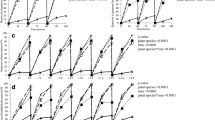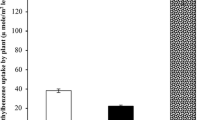Abstract
Indoor air pollution is of increasing concern for human health. Amongst the volatile organic compounds (VOCs) found indoors, formaldehyde and toluene are two toxic compounds. Indoor plants have an innate capability to remediate indoor airborne pollutants. Zamioculcas zamiifolia is an ornamental plant local to Thailand reported to be very efficient for VOC removal. Indole acetic acid (IAA) was applied to shoots and roots of Z. zamiifolia to enhance the capability for removing a toluene and formaldehyde mixture. We found that 5 μM of exogenous IAA can enhance Z. zamiifolia efficiency about 20% and 40% for toluene and formaldehyde, respectively, after plant was exposed to initial toluene-formaldehyde mixture concentration 20 ppm (1:1) for 3 cycles (156 h). We found that 5 μM of exogenous IAA had a positive effect on the stomatal aperture opening and stomatal conductance. However, 10 μM of exogenous IAA had a negative effect on the opening of stomatal aperture, and thus initially decreased that remediating ability of Z. zamiifolia for formaldehyde and toluene. We investigated the formaldehyde dehydrogenase activity in shoots of Z. zamiifolia and found significantly enhanced FDH activity in plants supplied with exogenous IAA. We concluded that exogenous IAA in optimum amounts could enhance the mitigating ability of indoor plants for airborne air pollutants. However, our research indicated that the application of IAA to roots could have a negative effect on the remediating ability of Z. zamiifolia.





Similar content being viewed by others
References
Ballester F, Estarlich M, Iñiguez C, Llop S, Ramón R, Esplugues A, Lacasaña M, Rebagliato M (2010) Air pollution exposure during pregnancy and reduced birth size: a prospective birth cohort study in Valencia, Spain. Environ Health 9:6. https://doi.org/10.1186/1476-069X-9-6
Brewer PB, Dun EA, Ferguson BJ, Rameau C, Beveridge CA (2009) Strigolactone acts downstream of auxin to regulate bud outgrowth in pea and Arabidopsis. Plant Physiol 150:482–493. https://doi.org/10.1104/pp.108.134783
Cruz MD, Christensen JH, Thomsen JD, Müller R (2014) Can ornamental potted plants remove volatile organic compounds from indoor air? —a review. Environ Sci Pollut Res 21:13909–13928. https://doi.org/10.1007/s11356-014-3240-x
Daszkowska-Golec A, Szarejko I (2013) Open or close the gate–stomata action under the control of phytohormones in drought stress conditions. Front Plant Sci 4:138. https://doi.org/10.3389/fpls.2013.00138
Devi RG, Pandiyarajan V, Gurusaravanan P (2012) Alleviating effect of IAA on salt stressed Phaseolus mungo (L.) with reference to growth and biochemical characteristics. Recent Research in Science and Technology 4:3. https://updatepublishing.com/journal/index.php/rrst/article/view/879. Accessed 10 Mar 2012
Giese M, Bauer-Doranth U, Langebartels C, Jr HS (1994) Detoxification of formaldehyde by the spider plant (Chlorophytum comosum L.) and by soybean (Glycine max L.) cell-suspension cultures. Plant Physiol 104:1301–1309. https://doi.org/10.1104/pp.104.4.1301
Gordon SA, Weber RP (1951) Colorimetric estimation of indoleacetic acid. Plant Physiol 26:192–195. https://doi.org/10.1104/pp.26.1.192
Grandjean P, Landrigan PJ (2006) Developmental neurotoxicity of industrial chemicals. Lancet 368:2167–2178. https://doi.org/10.1016/S0140-6736(07)60396-1
Gupta KC, Ulsamer AG, Preuss PW (1982) Formaldehyde in indoor air: sources and toxicity. Environ Int 8:349–358. https://doi.org/10.1016/0160-4120(82)90049-6
Hu Y, Wu Q, Peng Z, Sprague SA, Wang W, Park J, Akhunov E, Jagadish KS, Nakata PA, Cheng N (2017) Silencing of OsGRXS17 in rice improves drought stress tolerance by modulating ROS accumulation and stomatal closure. Sci Rep 7:15950. https://doi.org/10.1007/s11103-005-2159-5
Irga PJ, Paull NJ, Abdo P, Torpy FR (2017) An assessment of the atmospheric particle removal efficiency of an in-room botanical biofilter system. Build Environ 115:281–290. https://doi.org/10.1016/j.buildenv.2017.01.035
Irga PJ, Pettit T, Irga RF, Paull NJ, Douglas ANJ, Torpy FR (2019) Does plant species selection in functional active green walls influence VOC phytoremediation efficiency? Environ Sci Pollut Res 26:12851–12858. https://doi.org/10.1007/s11356-019-04719-9
Kaya C, Tuna AL, Okant AM (2010) Effect of foliar applied kinetin and indole acetic acid on maize plants grown under saline conditions. Turk J Agric For 34:529–538. https://doi.org/10.3906/tar-0906-173
Kaya C, Ashraf M, Dikilitas M, Tuna AL (2013) Alleviation of salt stress-induced adverse effects on maize plants by exogenous application of indoleacetic acid (IAA) and inorganic nutrients-a field trial. Aust J Crop Sci 7:249. https://doi.org/10.1007/s10535-012-0144-9
Keller BU, Hedrich R, Raschke K (1989) Voltage-dependent anion channels in the plasma membrane of guard cells. Nature 341:450–453. https://doi.org/10.1016/j.febslet.2010.02.049
Khaksar G, Siswanto D, Treesubsuntorn C, Thiravetyan P (2016a) Euphorbia milii -endophytic bacteria interactions affect hormonal levels of the native host differently under various airborne pollutants. MPMI 29:663–673. https://doi.org/10.1094/MPMI-06-16-0117-R
Khaksar G, Treesubsuntorn C, Thiravetyan P (2016b) Endophytic Bacillus cereus ERBP—Clitoria ternatea interactions: potentials for the enhancement of gaseous formaldehyde removal. Environ Exp Bot 126:10–20. https://doi.org/10.1016/j.envexpbot.2016.02.009
Khaksar G, Treesubsuntorn C, Thiravetyan P (2017a) Impact of endophytic colonization patterns on Zamioculcas zamiifolia stress response and in regulating ROS, tryptophan and IAA levels under airborne formaldehyde and formaldehyde-contaminated soil conditions. Plant Physiol Biochem 114:1–9. https://doi.org/10.1016/j.plaphy.2017.02.016
Khaksar G, Treesubsuntorn C, Thiravetyan P (2017b) Effect of exogenous methyl jasmonate on airborne benzene removal by Zamioculcas zamiifolia: the role of cytochrome P450 expression, salicylic acid, IAA, ROS and antioxidant activity. Environ Exp Bot 138:130–138. https://doi.org/10.1016/j.envexpbot.2017.03.007
Kilian J, Whitehead D, Horak J, Wanke D, Weinl S, Batistic O, D’Angelo C, Bornberg-Bauer E, Kudla J, Harter K (2007) The AtGenExpress global stress expression data set: protocols, evaluation and model data analysis of UV-B light, drought and cold stress responses. Plant J 50:347–363. https://doi.org/10.1111/j.1365-313X.2007.03052.x
Kim KJ, Jeong MI, Lee DW, Song JS, Kim HD, Yoo EH, Jeong SJ, Han SW, Kays SJ, Lim YW, Kim HH (2010) Variation in formaldehyde removal efficiency among indoor plant species. Hort Sci 45:1489–1495. https://doi.org/10.21273/HORTSCI.45.10.1489
Lee J, Hyunkyung K (2015) The effect of improving indoor air quality using some C3 plants and CAM plants. Indian J Sci Technol 8:1–17. https://doi.org/10.17485/ijst/2015/v8i26/80693
Leggat PA, Kedjarune U, Smith DR (2007) Occupational health problems in modern dentistry: a review. Ind Health 45:611–621. https://doi.org/10.2486/indhealth.45.611
Lohse G, Hedrich R (1992) Characterization of the plasma membrane H+-ATPase from Vicia faba guard cells. Planta 188:206–214. https://doi.org/10.1007/BF00216815
Mahmood M, Bidabadi SS, Ghobadi C, Gray DJ (2012) Effect of methyl jasmonate treatments on alleviation of polyethylene glycol-mediated water stress in banana (Musa acuminata cv.‘Berangan’, AAA) shoot tip cultures. Plant Growth Regul 68:161–169. https://doi.org/10.1007/s10725-012-9702-6
Marten I, Lohse G, Hedrich R (1991) Plant growth hormones control the voltage-dependent activity of anion channels in the plasma membrane of guard cells. Nature 353:758
Pettit T, Irga PJ, Torpy FR (2018) The in situ pilot-scale phytoremediation of airborne VOCs and particulate matter with an active green wall. Air Qual Atmos Health 12:34–44. https://doi.org/10.1007/s11869-018-0628-7
Pettit T, Bettes M, Chapman AR, Hoch LM, James ND, Irga PJ, Torpy FR (2019) The botanical biofiltration of VOCs with active airflow: is removal efficiency related to chemical properties? Atmos Environ 214:116839. https://doi.org/10.1016/j.atmosenv.2019.116839
Qiu Z, Guo J, Zhu A, Zhang L, Zhang M (2014) Exogenous jasmonic acid can enhance tolerance of wheat seedlings to salt stress. Ecotoxicol Environ Saf 104:202–208. https://doi.org/10.1016/j.ecoenv.2014.03.014
Ribaut JM, Pilet PE (1994) Water stress and indol-3yl-acetic acid content of maize roots. Planta 193:502–507. https://doi.org/10.1007/BF02411554
Schmitz H, Hilgers U, Weidner M (2000) Assimilation and metabolism of formaldehyde by leaves appear unlikely to be of value for indoor air purification. New Phytol 147(2):307–315
Sewelam N, Kazan K, Schenk P (2016) Global plant stress signaling: reactive oxygen species at the cross-road. Front Plant Sci 7:187. https://doi.org/10.3389/fpls.2016.00187
Shao Y, Wang Y, Zhao R, Chen J, Zhang F, Linhardt RJ, Zhong W (2020) Biotechnology progress for removal of indoor gaseous formaldehyde. Appl Microbiol Biotechnol:1–13. https://doi.org/10.1007/s00253-020-10514-1
Sinha BK, Basu SP (1981) Indole-3-acetic acid and its metabolism in root nodules of Pongamia pinnata (L.) PIERRE. Biochem Physiol Pflanz 176:218–227. https://doi.org/10.1016/S0015-3796(81)80074-1
Siswanto D, Permana, BH, Treesubsuntorn C, Thiravetyanc P (2020) Sansevieria trifasciata and Chlorophytum comosum botanical biofilter for cigarette smoke phytoremediation in a pilot-scale experiment – evaluation of multi-pollutant removal efficiency and CO2 emission, Air Qual Atmos Health, 13, pages109–117. doi: https://doi.org/10.1007/s11869-019-00775-9, 109
Snaith PJ, Mansfield TA (1982) Control of the co 2 responses of stomata by Indol-3ylacetic acid and Abscisic acid. J Exp Bot 33:360–365. https://doi.org/10.1093/jxb/33.2.360
Sriprapat W, Thiravetyan P (2013) Phytoremediation of BTEX from indoor air by Zamioculcas zamiifolia. Water Air Soil Pollut 224:1482. https://doi.org/10.1007/s11270-013-1482-8
Sriprapat W, Suksabye P, Areephak S, Klantup P, Waraha A, Sawattan A, Thiravetyan P (2014) Uptake of toluene and ethylbenzene by plants: removal of volatile indoor air contaminants. Ecotoxicol Environ Saf 102:147–151. https://doi.org/10.1016/j.ecoenv.2014.01.032
Tang X, Bai Y, Duong A, Smith MT, Li L, Zhang L (2009) Formaldehyde in China: production, consumption, exposure levels, and health effects. Environ Int 35:1210–1224. https://doi.org/10.1016/j.envint.2009.06.002
Torpy FR, Zavattaro M, Irga PJ (2017a) Green wall technology for the phytoremediation of indoor air: a system for the reduction of high CO2 concentrations. Air Qual Atmos Health 5:575–585. https://doi.org/10.1007/s11869-016-0452-x
Torpy FR, Clements N, Pollinger M, Dengel A, Mulvihill I, He C, Irga PJ (2017b) Testing the single-pass VOC removal efficiency of an active green wall using methyl ethyl ketone (MEK). Air Qual Atmos Health 11:163–170. https://doi.org/10.1007/s11869-017-0518-4
Treesubsuntorn C, Thiravetyan P (2018) Botanical biofilter for indoor toluene removal and reduction of carbon dioxide emission under low light intensity by using mixed C3 and CAM plants. J Clean Prod 194:94–100. https://doi.org/10.1016/j.jclepro.2018.05.141
Wolverton BC, McDonald RC, Watkins EA Jr (1984) Foliage plants for removing indoor air pollutants from energy-efficient homes. Econ Bot. https://www.greenenergyhelps.com/wp-content/uploads/2013/04/Wolverton-et-al-1984.pdf. Accessed 1 Apr 1984
Wolverton BC, Johnson A et al (1989) Interior landscape plants for indoor air pollution abatement. NASA Stennis Space Center; Stennis Space Center, MS, United States. http://hdl.handle.net/2060/19930073077. Accessed 15 Sept 1989
Acknowledgements
The authors would like to thank King Mongkut’s University of Technology (KMUTT) and National Research Council of Thailand for funding this work and financially supporting Mr. Haseeb through the Petchra Pra Jom Klao Ph. D Scholarship (Academic Year 1/2016, contract number 51).
Author information
Authors and Affiliations
Contributions
Haseeb Ullah prepared and conducted in the experiments. Chairat Treesubsuntorn designed the experiments, analysed the data and draft the manuscript. Paitip Thiravetyan conceived the idea, designed the experiments and analysed the data. All the authors discussed and finalized the paper.
Corresponding author
Additional information
Publisher’s note
Springer Nature remains neutral with regard to jurisdictional claims in published maps and institutional affiliations.
Rights and permissions
About this article
Cite this article
Ullah, H., Treesubsuntorn, C. & Thiravetyan, P. Application of exogenous indole-3-acetic acid on shoots of Zamioculcas zamiifolia for enhancing toluene and formaldehyde removal. Air Qual Atmos Health 13, 575–583 (2020). https://doi.org/10.1007/s11869-020-00820-y
Received:
Accepted:
Published:
Issue Date:
DOI: https://doi.org/10.1007/s11869-020-00820-y




